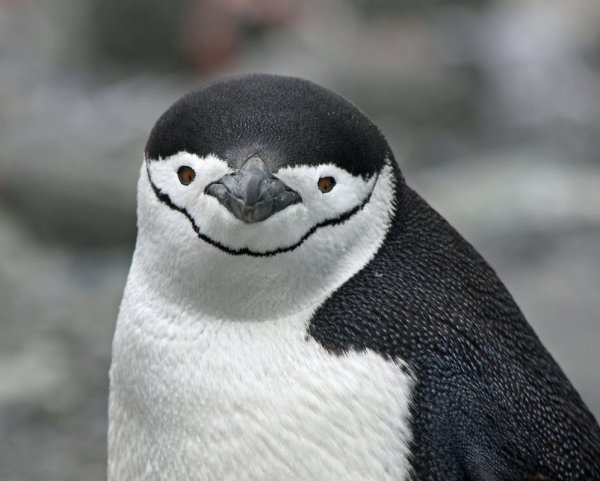Today, It’s All About the Penguins!
April 25, 2013
Today’s Feature Story for World Penguin Day is from respected Antarctic penguin expert David Ainley ~ Ed.

Penguins have been around on Earth for a long time. The first ones appeared in the geologic record 65 million years ago just after the mass extinction of animals (including dinosaurs) that ended the Cretaceous Period. Many reptilian species that had been their competitors had disappeared. Quickly, geologically speaking, penguins radiated into more than 50 different species, ranging in size from ones similar in size to the smallest one present now (Little Penguin, 1/3 m tall, 1200 g) to ones much larger than the largest now (Emperor Penguin, 1 m tall, 35 kg), that is, an ancient penguin that was 1.8 m tall and 80 kg.
Just as being released from competition by the disappearance of competitors allowed many new penguin species to evolve, competition eventually resulted in the demise of many penguins, and this resulted due to the appearance of seals and dolphins 25-50 million years ago. While penguins were very efficient at exploiting the ocean’s resources, nevertheless they are still birds and have to remain close to land where they build nests and raise their young. Dolphins and porpoises, however, do not have to do this and thus were far better than penguins in exploiting the sea’s riches. Especially the larger penguins, i.e. those more the size of dolphins, disappeared.
German researchers have shown that penguins are perhaps the most efficient divers of any air breathing creature. Their small, scale-like feathers act like, well, scales, which besides protecting their bodies from the cold water, reduce the surface tension of the water, just like the scales on the underside of a surfboard. It’s kind of like having body grease! Unlike dolphins and seals, penguins can also change the shape of their bodies, from short and fat to long and thin, depending on the speed they need to achieve. Even fish can’t do that! In short bursts, penguins can swim as fast as any fish, or they can just ‘hang’ in the water without moving at all. They are extremely maneuverable, being able to ‘turn on a dime,’ just like any fish.
Today, penguins are still competing for food and as in their geologic past not doing very well. Nowadays, however, the competitor is humans and their fishing vessels. Humans think that the oceans and its riches belong to them, and that other species deserve only to be relegated to the periphery. Unlike humans, penguins have no other choice for food than fish, and it has to be close to breeding colonies and plentiful. It is energetically very costly for penguins to dive for their fish; just imagine how breathless you are after swimming the length of pool as fast as you can! Humans drive their boats thousands of kilometers to extract ocean resources just about anywhere that they wish. Penguins be damned!
 A few penguin species have gone extinct owing to human activities (as has the Great Auk, an unrelated penguin-looking bird after whom the word, penguin, originated). As for the others, most of the currently existing 19 penguin species are in trouble mainly due to over exploitation of the sea, as well as to marine oil spills. Seven species are included on the US Endangered Species list; their total numbers are in the low thousands and they are confined to just a few localities. Included are Galapagos, Humboldt, African, Yellow-eyed, White-flippered (Little), Fiordland crested, and Erect-crested penguin. Other species, for example the Gentoo penguin has seen its populations reduced by 50% in most of its range once humans started extracting fish from their waters. Yes, the penguins of the film, “Happy Feet,” cried out to humans, “Stop eating our fish!”
A few penguin species have gone extinct owing to human activities (as has the Great Auk, an unrelated penguin-looking bird after whom the word, penguin, originated). As for the others, most of the currently existing 19 penguin species are in trouble mainly due to over exploitation of the sea, as well as to marine oil spills. Seven species are included on the US Endangered Species list; their total numbers are in the low thousands and they are confined to just a few localities. Included are Galapagos, Humboldt, African, Yellow-eyed, White-flippered (Little), Fiordland crested, and Erect-crested penguin. Other species, for example the Gentoo penguin has seen its populations reduced by 50% in most of its range once humans started extracting fish from their waters. Yes, the penguins of the film, “Happy Feet,” cried out to humans, “Stop eating our fish!”
Nowadays, the only place left in the ocean where penguins have not had to deal with human exploitation, until recently has been the Ross Sea, Antarctica, which is the farthest away from fishing ports of anywhere on Earth. In those waters, less than 1% of the World Ocean, are 38% of the world’s Adélie Penguins and 25% of the world’s Emperor Penguins. In their arrogance, however, those waters have been discovered by fishing fleets and now there is nowhere on Earth where penguins can exist without competing with humans for food. The Ross Sea is one of Sylvia Earle’s “Hope Spots” for preservation and an attempt has been made to declare it a marine protected area. However, the fishing powers are not listening (see www.lastocean.org, www.penguinscience.com.)









